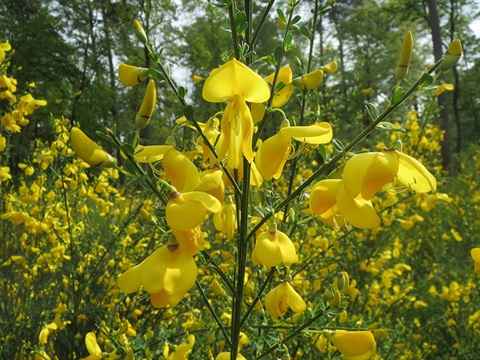English Broom

Cytisus scoparius
Declared Noxious Weed
Origin: Europe
Size: 1m–3m H, 1m–2.5m W
Best removal time: Before seeds form
Flowers: October to January
Fruits: December to March
What it does
This plant invades all areas except heavily shaded or swampy places. It is a vigorous plant that overtakes large areas, preventing indigenous vegetation from growing. Seeds remain viable in the soil for a long time.
What it looks like
English Broom is an upright evergreen shrub. It has many woody prominently ridged stems that are usually green to brownish-green in colour. The leaves are small, green, are short stalked and have fine hairs. Plants become leafless. It has yellow or yellow and red pea type flowers which bloom in spring.
This plant is a declared noxious weed. It has the potential to spread widely and cause serious economic loss to agriculture, or have some detrimental effect upon people, animals, the environment or the local community.
How it spreads
English Broom spreads by:
- birds
- animals
- ants
- machinery
- water
- garden waste
- contaminated soil
- hybrid plants are available at nurseries, markets and fetes. Buyer beware!
Removal
Remove by hand
Small plants can easily be hand pulled when the soil is soft. It is best to try and remove the young plants before they begin to flower.
Cut and paint
This method may be more practical for larger plants. Cut close to the ground. Be sure to paint the cut with an undiluted glyphosate-based product as quickly as possible to ensure the plant absorbs the poison.
Spray with herbicide
Where there is a large infestation and hand pulling or the cut and paint method would not be appropriate, use a registered product and ensure you check the label and follow instructions. Ring the Department of Energy, Environment and Climate Action on 136 186 for full details.
Indigenous alternatives to plant
Many shrub alternatives exist that are indigenous to the Yarra Ranges region and would make great substitutes for English Broom. Some alternatives include:
How to dispose of weeds
By disposing of environmental weeds correctly you can prevent re-infestation on your property and elsewhere.
- Landfill (Weed Wipeout Tip vouchers available for some species).
- Green waste bins ensure that weeds are not able to spread.
- Woody weed stems can be bundled for green collection twice per annum.
- Composting (excluding seed heads or species with vegetative reproduction, e.g. Wandering Trad).
- Burning in accordance with Council and the Country Fire Authority (CFA) prescribed burning periods and regulations.
- Recovery and transfer stations available for weed tipping are Healesville, Wesburn, Coldstream, Lysterfield and Montrose.
Using chemicals
Non-chemical treatment is often the most effective and safe option especially on smaller scale infestations.
Where chemical use is undertaken:
- Always follow the manufacturer’s guidelines when using chemicals.
- Wear protective clothing and eyewear.
- When purchasing your herbicide, always ask for a Materials Safety Data Sheet (MSDS) or refer to the manufacturer’s website for specific safety guidelines and information.
- Some herbicides will kill other plants and not just the target species.
- When used near waterways herbicides can be very poisonous to aquatic life.
- Use chemicals sparingly and be sure that you are using the right chemical and application technique.
- Ensure the weather conditions are suitable (e.g. minimal wind and no rain expected).
- Apply herbicides at the correct time during the plant’s growth cycle so you get the best results.